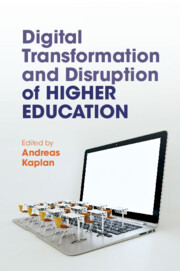Book contents
- Digital Transformation and Disruption of Higher Education
- Digital Transformation and Disruption of Higher Education
- Copyright page
- Contents
- Figures
- Tables
- Contributors
- Preface
- Chapter 1 Nothing Is Constant Except Change
- Part I (R)evolution of the Higher Education Sector
- Part II Changes in Teaching Formats
- Part III Changes in Teaching Content
- Part IV Networking and Social Activities
- Part V Certification and Diplomas
- Chapter 19 Shared Learning in Higher Education
- Chapter 20 Degrees of Disruption
- Chapter 21 Born-Digital Universities
- Chapter 22 Personalisation of Higher Education
- Part VI Careers and Professionalisation
- Part VII Futuristic and Ultramodern Higher Education
- Part VIII Higher Education in Motion
- Editor’s Biography
- Index
- References
Chapter 19 - Shared Learning in Higher Education
Toward a Digitally Induced Model
from Part V - Certification and Diplomas
Published online by Cambridge University Press: 09 June 2022
- Digital Transformation and Disruption of Higher Education
- Digital Transformation and Disruption of Higher Education
- Copyright page
- Contents
- Figures
- Tables
- Contributors
- Preface
- Chapter 1 Nothing Is Constant Except Change
- Part I (R)evolution of the Higher Education Sector
- Part II Changes in Teaching Formats
- Part III Changes in Teaching Content
- Part IV Networking and Social Activities
- Part V Certification and Diplomas
- Chapter 19 Shared Learning in Higher Education
- Chapter 20 Degrees of Disruption
- Chapter 21 Born-Digital Universities
- Chapter 22 Personalisation of Higher Education
- Part VI Careers and Professionalisation
- Part VII Futuristic and Ultramodern Higher Education
- Part VIII Higher Education in Motion
- Editor’s Biography
- Index
- References
Summary
This chapter examines the origins and the future role of digitally induced shared learning and, in this context, of micro-credentials as a currency towards earning a degree qualification, possibly in combination with the flexibility where to seek the qualification. We argue that the general trend towards the deinstitutionalization of tertiary education, to be understood as the unbundling and re-bundling of educational services, will help to make digitally based micro-credentials fungible by taking advantage of the so far reluctantly utilized degrees of freedom for accreditation and assessment more liberally. The COVID pandemic is encouraging a merger of the world of theoretically face-to-face programmes, now delivered virtually, and the world of MOOCs and micro-credentials. It will ultimately change the underlying economics of shared learning and will thereby help to make it a core feature of a much more accessible higher education.
Keywords
Information
- Type
- Chapter
- Information
- Digital Transformation and Disruption of Higher Education , pp. 239 - 254Publisher: Cambridge University PressPrint publication year: 2022
